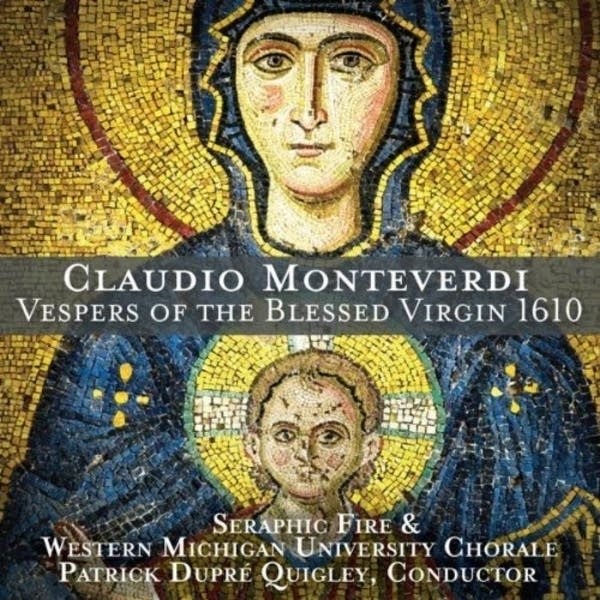
Eight years ago, Patrick Quigley moved to Miami after completing his master's degree in conducting at Yale. He immediately began congregating with several other singers, and they decided to put on a show. That's how the professional choral ensemble Seraphic Fire was born.
The goal of Seraphic Fire is to shed new light on familiar works and to premiere and commission works by up-and-coming composers. Their latest recording features Claudio Monteverdi's 'Vespers of the Blessed Virgin 1610' and worked its way into the top 10 of classical iTunes just two days after it was released. "Two weeks later," Quigley explains, "my friend Jeff London did a piece on us for Weekend All Things Considered, and within an hour of that airing on a Saturday afternoon, we were number one on the classical iTunes list and remained there a long time!" For a few brief moments, they even surpassed Lady Gaga on the iTunes all-genre chart!
Today Monteverdi's Vespers are often performed with massive forces. For the past several years, Seraphic Fire has experimented with paring down the number of performers to create a smaller, more intimate sound. To Quigley, this 400-year-old music sounds fresh even today. "Another great part about this piece is that every time you hear it you hear something different," Quigley enthuses. "I've conducted it about 18 times now, through the tour, through Mexico and two different performance periods in South Florida, as well as many hours of recording, and every time I put on our disc or someone else's I hear a different thing which I've never heard before, and that ability to have music sound so new even after 400 years--that says something about the piece of music."
Patrick Quigley's artistic partner for Seraphic Fire, James Bass, is also director of Choral Studies in the School of Music at Western Michigan University. On this recording, Seraphic Fire collaborates with the Western Michigan University Chorale. When the time came to record these Vespers, in a small stone chapel outside Kalamazoo, Michigan, an amazing synergy developed between the student singers and the professionals of Seraphic Fire. This synergy is heard in several movements of the Vespers, including the second movement titled, Dixit Dominus. "The Dixit Dominus, in the course of its seven and a half minutes, is a thrilling romp in a way," explains Patrick Quigley. "He has incredible moments where every voice in the chorus is singing at the limit of its range and volume capacity. There are some rhythmic moments, the De Torrente in Via, where Monteverdi takes a line which is written in three, and layers it over, which makes it feel like the water is cascading over it. It talks about a river growing into a torrent, and he really illustrates that quite well with the voices."
Laudate Pueri, the fourth movement of the vespers, is one Quigley most looks forward to. "This is actually my favorite movement of the piece. The voices often sing in pairs, but the real amazing part of it is that it starts with a single voice singing the tenor line and then reaches this beautiful eight-part homophonic, flowing, rich texture, and then from there goes through a romping Gloria Patri and then decrescendos back to the one tenor voice that started the piece in the first place."
According to Quigley the sixth movement gives us a preview of what jazz may have sounded like 400 years ago. "The Laetatus Sum is based on the text, 'I was glad when they said unto me, let us go to the house of the Lord, our feet are standing in thy gates, O Jerusalem.' And through the entire time, perhaps one of the earlier instances of a walking bassline which we would hear certainly in a lot of jazz now, but the continuo line is this constant set of quarter notes which repeat the same pattern over and over again, almost like a ground in a way. It sounds like it could be in a jazz club in New York, but it's his way of illustrating this sort of pilgrimage to Jerusalem of the faithful, slowly but surely marching toward the holy city."
There are moments on this recording of the "Vespers of the Blessed Virgin" which may very well take your breath away. When Monteverdi's dissonances resolved, and then echoed perfectly throughout that small stone chapel, Seraphic Fire and the Western Michigan University Chorale knew they were experiencing something thrilling--an experience they now share with a wider audience.
As for the group's name: "The ensemble is named Seraphic Fire because the first piece that we performed was William Billings' 'Invocation,' which starts, 'Majestic God our music inspire and fill us with seraphic fire,'" Quigley explains. "So it's the first line we ever sang. We thought it sort of sounded like the Miami Heat in a way, so it stuck."
Love the music?
Show your support by making a gift to YourClassical.
Each day, we’re here for you with thoughtful streams that set the tone for your day – not to mention the stories and programs that inspire you to new discovery and help you explore the music you love.
YourClassical is available for free, because we are listener-supported public media. Take a moment to make your gift today.
Your Donation
About New Classical Tracks®
Host Julie Amacher provides an in-depth exploration of a new classical music release each week.
Subscribe on Apple Podcasts, Spotify, Radio Public, or RSS.












